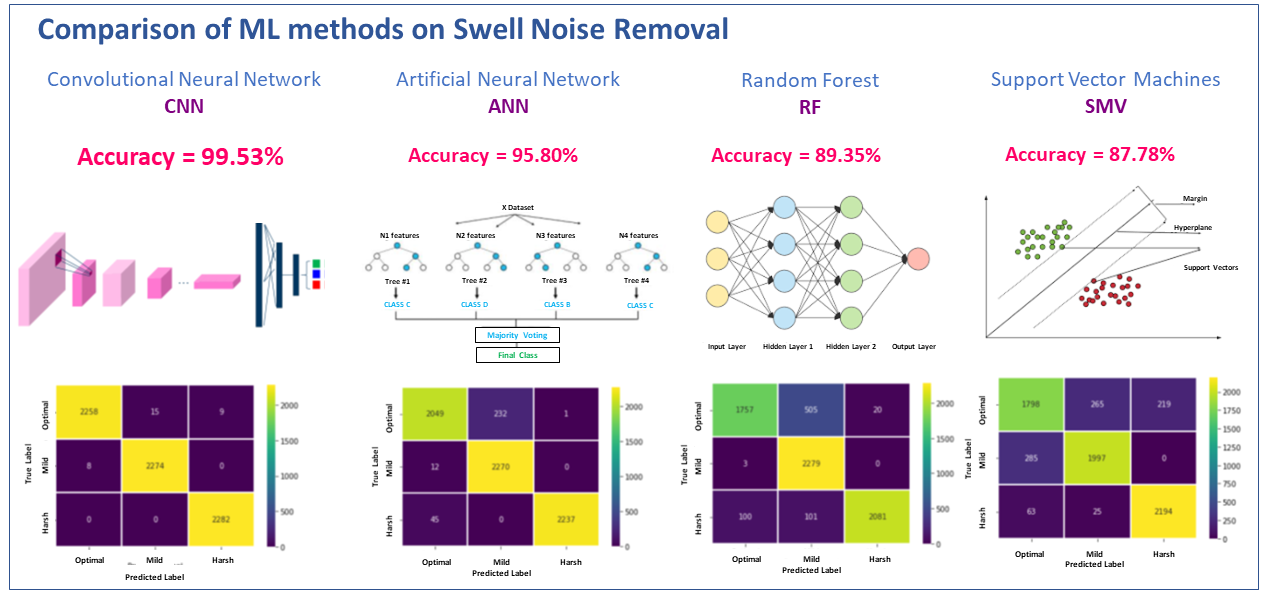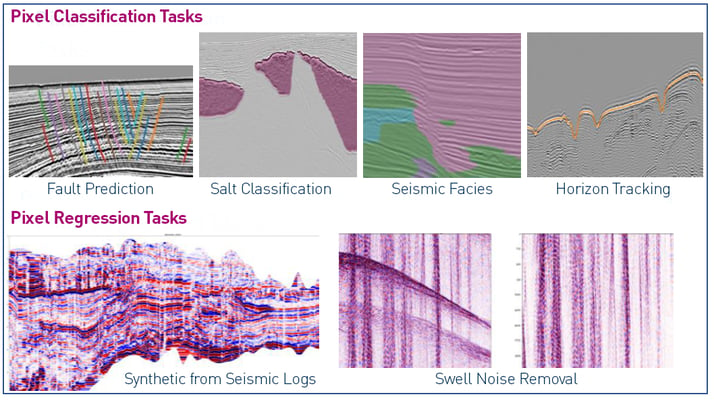| TGS insights give you the stories behind Energy data. These regular short 3-5 minute reads feature thought-provoking content to illustrate the use of energy data in providing insight, nurturing innovation, and achieving success. |
The next frontier in Geoscience has arrived and it is firmly rooted in artificial intelligence and machine learning.
The natural process of wave formation within large bodies of water has a dramatic effect on seismic imaging. Swell Noise, the noise created by surface waves passing through seismic surveys, is picked up on the geophones and creates an interference that can distort the incoming sound waves carrying back vital information on the Earth's interior. The accuracy of the images derived from sound waves collected while racing back to the surface after reflecting off various layers and structures within the Earth depends greatly on the signal's quality produced by the reflected energy from the material within the Earth while ignoring the noise of competing energy.
The process of removing the swell noise from the survey without damaging the reflected waves of interest is a science that has been perfected and implemented in seismic processing since its inception. The proper removal of the swell noise helps produce a clear seismic image that can be interpreted with minimal risk. Traditionally, this early step in the processing workflow requires numerous quality control (QC) procedures that require special attention and fine-tuning of parameters - a labor-intensive process that can take a significant amount of time and computing power to accomplish.
Attention in the industry has turned to the value that machine learning techniques can bring in the removal of swell noise. These techniques can be used to dramatically speed up processing time and efficiency while maintaining high standards of quality. A recent study by the TGS R&D team compared several machine learning methods trained on a unique dataset providing quantifiable results to measure the accuracy of each technique. Methods known as Support Vector Machines (SVM), Random Forest (RF), Artificial Neural Networks (ANN) and Convolutional Neural Networks (CNN) were all tested. Results concluded that a Convolutional Neural Network (CNN) could re-construct shot gathers to an accuracy of 99.53%. The trained CNN model was also able to provide swell noise removal results on seismic datasets found in different basins other than where the training set was derived. This demonstrated the potential of the CNN model to be trained on data from a range of geographically diverse areas.
Machine Learning (ML) methods compared in swell noise removal testing on seismic datasets. Results show the CNN model performed with the greatest accuracy.
With this level of accuracy and flexibility, it is theorized that this method could be used to complement, or even replace, the early stages of coherent noise removal during the seismic processing workflow. Testing and research for this study were conducted on a small-scale dataset. It illustrated how the use of CNN and other machine learning techniques could solve many time-consuming drawbacks inherent in traditional methods. Continued research, development, and testing are underway to establish the usefulness of these methods on large-scale seismic surveys.
Advancing Technologies
Artificial Intelligence (AI) and Machine Learning (ML) are technologies that have advanced exponentially over the past ten years. In 2012 AlexNet, the award-winning Convolutional Neural Network (CNN), contained 60 million parameters. In 2020, OpenAI's "GPT-3" trained on 175 billion parameters, a 3,000-fold increase in 8 years. In early 2021 Google announced that they had trained a 1.6 trillion parameter model beating the previous best by a magnitude of 9 in less than a year. This growth indicates that investors have faith in AI and ML's benefits in solving increasingly complex problems in new, more efficient ways.
Energy data expert TGS was an early adopter and developer of AI and ML technologies. Leveraging the company's decades of knowledge in utilizing advanced algorithms and employing extensive computational power to solve complex geophysics puzzles made the transition to new AI and ML methodologies easy. This integration of technology with existing knowledge and a vast library of energy data has helped advance the companies goals.
In particular, ML, deep learning and neural networks have had a profound impact on many geoscience workflows. Like other imaging mediums, seismic images are composed of individual pixels in 2D space and voxels in 3D space. Each of these individual pixels/voxels contains data used to analyze trends within the image. Pixel classification within the seismic image has benefited greatly from improved ML techniques, including the interpretation techniques of horizon tracking, fault prediction, seismic facies and salt classification. These methods, combined with gains in computational power, are able to quickly accomplish complex pixel/voxel classifications making it possible to increase processing cycles, provide more detail to interpreters and lead to a more detailed seismic image. In addition, the increased accuracy and reliability of these techniques have helped reduce processing time and increased seismic processing quality significantly over the past ten years.
Synthetic interpretation created from well log databases is also possible with ML, allowing petrophysical data to be reliably interpreted between wells, reducing risk and making it possible for geologists and engineers to better model reservoir systems. New ML models are being built utilizing petrophysical data and seismic data. These help engineers and geoscientists find more than just oil, gas and minerals; they are also helping to optimize carbon storage and geothermal energy solutions.
Historic well log and production databases provide an abundance of physical and chemical datapoints ML techniques can exploit to provide subsurface intelligence. The Department of Energy (DOE) has begun the Carbon Capture Simulation for Industry Impact (COSI2); an initiative driven by national laboratories, universities and industry to develop and advance AI and ML tools to advance CO2 storage. Recently the DOE awarded $3.5 million to four projects designed to advance research in ML for geothermal energy. These projects will use ML to analyze large, complicated datasets of lab and field data to model new ways to achieve reliable, cost-effective geothermal energy solutions.

Images depicting results following ML pixel classification and regression tasks. These ML methods greatly increase workflows.
The Future is Limitless
The benefits of AI and ML have changed many of our day-to-day workflows, allowing us to solve very complex problems in very little time and making it possible for us to break through the barriers presented by previously resource-intensive processes. The ideas we can harness and see through to creation due to AI and ML assistance are quickly becoming limitless. This is particularly relevant to new energy solutions, including CO2 storage, geothermal energy, deep-sea mining, wind and solar energy. Data concerning these initiatives have been collected for decades and reside in numerous databases waiting for AI/ML technologies to compile, classify and provide solutions to advance the industries. Governments and commercial enterprises are investing heavily in building new energy solutions and reducing the environmental impact of energy generation. AI and ML are the building blocks we will need to achieve our energy goals with optimum efficiency.


